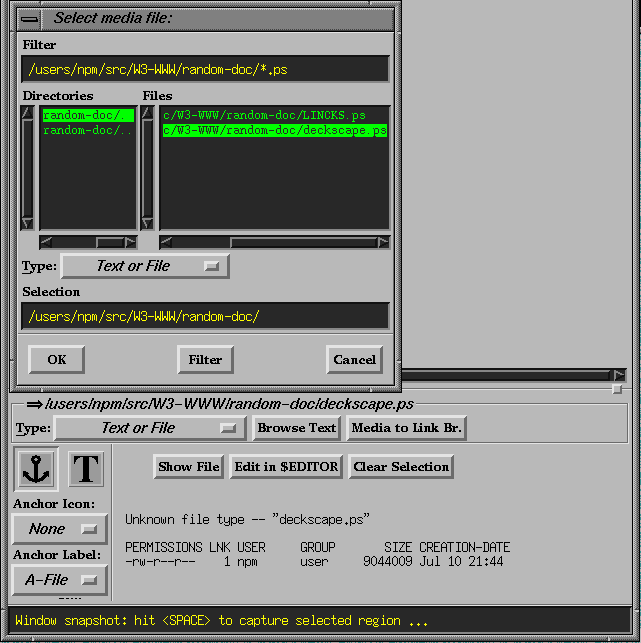 |
The ``unknown'' media type is reserved for large files that don't appear to be textual, nor match any of the aforementioned media types. Typically, these files are site, job, or application-specific file types produced by the engineer's own tools. This media type allows the engineer to see some statistics on some application-specific file dropped into the document being authored - for example, the actual CAD data file describing a mechanical part being documented or discussed in the given document.
It is possible to customize one's WWW browser to make the appropriate calls to an external program when such an ``unknown'' file type is browsed.
For example, the following allows an already running FrameMaker![[*]](foot_motif.gif) application to
pop up a window editing/viewing a FrameMaker document each time a a file
with the extensions ``.doc'', ``.fm'', ``.frm'', ``.frame'', or ``.maker''
is browsed (by clicking on a link in a web browser). First, one adds the
following to one's
application to
pop up a window editing/viewing a FrameMaker document each time a a file
with the extensions ``.doc'', ``.fm'', ``.frm'', ``.frame'', or ``.maker''
is browsed (by clicking on a link in a web browser). First, one adds the
following to one's ~/.mailcap file:
application/x-framemaker; fmclient -f /%s;then one adds the following to the
~/.mime.types file:
type=application/x-framemaker exts=doc,fm,frm,frame,maker
Figure 9 shows a Postscript![[*]](foot_motif.gif) file as current selection in the
media browser. Postscript is widely used, but not necessarily a web de-facto
standard for displaying graphics and documents in a resolution independent
fashion. Since many browser vendors do not actively support postscript in
their browsers (i.e. if you don't already have a postscript previewer
installed on your system, you will never be able to view the data in a
hypertext link to a postscript file) we have not provided an explicit media
panel type for such semi-standard types, and use the ``unknown media type''
panel to allow insertion/browsing of such link types.
file as current selection in the
media browser. Postscript is widely used, but not necessarily a web de-facto
standard for displaying graphics and documents in a resolution independent
fashion. Since many browser vendors do not actively support postscript in
their browsers (i.e. if you don't already have a postscript previewer
installed on your system, you will never be able to view the data in a
hypertext link to a postscript file) we have not provided an explicit media
panel type for such semi-standard types, and use the ``unknown media type''
panel to allow insertion/browsing of such link types.